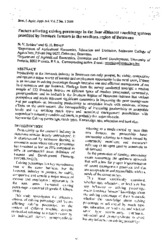| dc.contributor.author | Sebina, N. V. | |
| dc.contributor.author | Duvel, G.H. | |
| dc.date.accessioned | 2022-04-07T09:18:25Z | |
| dc.date.available | 2022-04-07T09:18:25Z | |
| dc.date.issued | 2008 | |
| dc.identifier.issn | 1815-5574 | |
| dc.identifier.uri | https://hdl.handle.net/13049/425 | |
| dc.description | Article, BOJAAS, 2008 | en_US |
| dc.description.abstract | Productivity in the livestock industry in Botswana can only prosper, be viable, competitive and remain a major source of income and employment opportunity in the rural areas, if there is an increase in calving percentage through intensive use and efficient management of our land resources and our livestock. Findings from the survey conducted amongst a random sample of 132 livestock farmers on different types of ranches (communal, community, group/syndicate and individual) in the Southern Region of Botswana indicate that various perceptions and needs represent significant constraints in improving the poor management and put emphasis on increasing productivity to acceptable levels with minimum adverse effects on the environment. The incompatibility of increasing productivity to acceptable levels and the resulting ranch types and associated management possibilities with respondent’s culturally conditioned needs, is probably the major obstacle. | en_US |
| dc.language.iso | en | en_US |
| dc.publisher | Botswana University of Agriculture & Natural Resources | en_US |
| dc.relation.ispartofseries | Botswana Journal of Agriculture and Applied Sciences;Vol. 5 (1): 2008 | |
| dc.subject | Calving percentage | en_US |
| dc.subject | Ranch types | en_US |
| dc.subject | Knowledge | en_US |
| dc.subject | Age | en_US |
| dc.subject | Education | en_US |
| dc.subject | Herd size | en_US |
| dc.title | Factors affecting calving percentage in the four different ranching systems practiced by livestock farmers in the southern region of Botswana | en_US |
| dc.type | Article | en_US |

